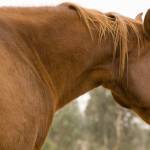Diagnosing Hindgut Acidosis and Predicting Laminitis Using LPS Binding Protein

When severe, hindgut acidosis can lead to laminitis, an excruciating and life-threatening inflammation of the sensitive tissues in the hoof. The presence of the bacterial product lipopolysaccharide (LPS) and LPS binding protein (LBP) in the bloodstream may serve as early indicators of hindgut acidosis in horses.
In a recent study, 16 horses were fitted with cecal cannulas, which are essentially “windows” that can be opened by veterinarians, providing access to the contents of the cecum.* The cecum is part of the equine hindgut, together with the voluminous large intestine. The cecum and large intestine function as a large fermentation vat that breaks down forage (hay and pasture) to produce volatile fatty acids—the primary source of energy for horses.
“Hindgut acidosis occurs when the pH of the cecum and large intestine decreases, becoming more acidic. According to research, increased acidity disrupts the intestinal microbiome, resulting in the lysis or destruction of gram-negative bacteria. Upon lysis, those bacteria release LPS, which is absorbed into the horse’s circulation,” explained Catherine Whitehouse, M.S., a nutritionist for Kentucky Equine Research.
One circulating LPS exerts potent pro-inflammatory effects and is believed to trigger inflammation of the hoof’s lamella, causing laminitis. LPS also stimulates the liver to produce LBP that attempts to neutralized LPS and limit its wave of destruction.
“One way of inducing hindgut acidosis is by feeding large amounts of high-starch feedstuffs such as corn or barley,” Whitehouse said.
Thus, the research team fed the 16 horses one of two diets: one with a high forage-to-concentrate ratio (70% forage and 30% concentrate) and the other a high-concentrate diet (30% forage and 70% concentrate). LBP and cecal pH were measured on days 0, 10, and 20. Horses were also examined for signs of laminitis, which was graded using the Obel grading system.
Key findings were:
- Horses fed a high-concentrate diet had an increased Obel laminitis score compared to horses on a high-forage diet over the course of the 20-day study period.
- Cecal pH decreased in the high-concentrate group from 6.3 to 5.81 in the first 10 days of the study. Cecal pH in the high-forage group remained constant over the 20-day study period, ranging from only 6.42 to 6.5.
- Mean LBP concentrations in the high-concentrate group were significantly increased at both 10 and 20 days compared to baseline. Further, LBP was significantly higher in the high-concentrate group on days 10 and 20 compared to the high-forage group.
The research team therefore suggested that LBP could serve as an early indicator of hindgut acidosis that might be useful for predicting laminitis.
“It should be noted that this study used an experimental diet to induce hindgut acidosis and measure inflammatory markers associated with laminitis. Under normal situations this type of diet would not be recommended by equine nutritionists,” acknowledged Whitehouse.
Ways to minimize hindgut acidosis include providing adequate amounts of forage. At least 50% of the diet should be forage, or a recommended absolute minimum intake of 1% of body weight.
“When large amounts of concentrate feed are needed to meet elevated energy demands, such as racehorses, early lactating mares, or hard keepers that need to gain weight, provide three to four meals per day spread out over the 24-hour period with four to six hours between meals,” advised Whitehouse.
Splitting large amounts of high-starch concentrate feed into multiple small meals like this reduces the risk of overwhelming foregut digestion. If large amounts of undigested nonstructural carbohydrates enter the hindgut, acidosis can develop, disrupting the microbiome.
“Performance horses on high-concentrate diets are not the only ones at risk of developing subclinical hindgut acidosis,” warned Whitehouse. “Any horse grazing lush pasture or those experiencing periods of stress can also be at risk.”
Supplying a targeted hindgut buffer such as EquiShure from Kentucky Equine Research can help horses maintain a more neutral hindgut environment to support digestive comfort and maintain health and performance.
*Firouzabadi, M.S., and A.P. Ardakani. 2024. Plasma concentration of serum amyloid A and lipopolysaccharide binding protein in horses with laminitis resulted from hindgut acidosis. Veterinary Journal: doi: 10.1016/j.tvjl.2024.106190.








